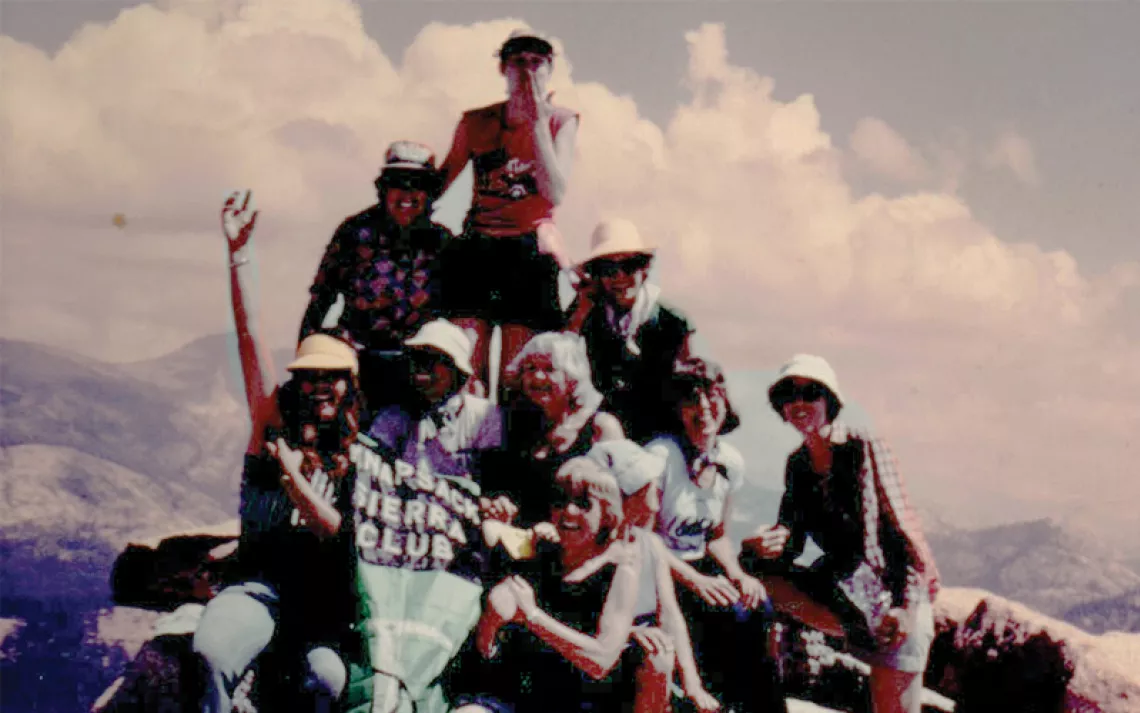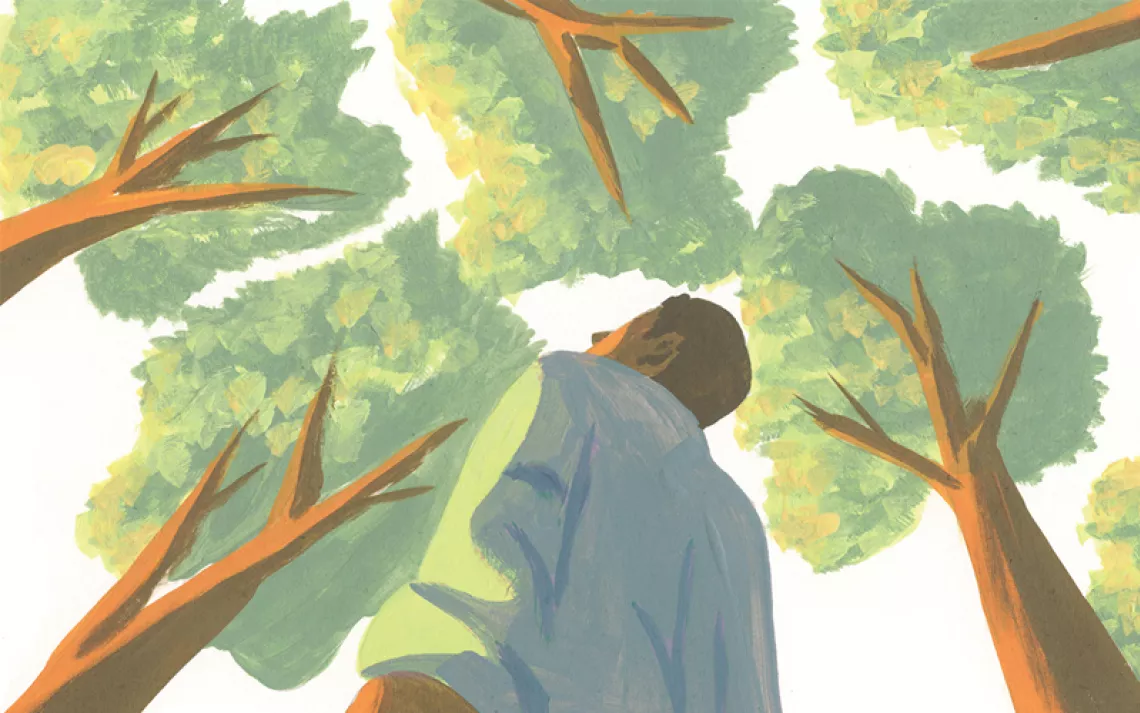Searching for the Sea Wolf of Quebec
A canoe journey through the wilds of Quebec, looking for a rare freshwater seal
After two days on the road, we pull into the hydroelectric boomtown of Radisson, Quebec, which rises like a mirage out of the endless taiga. It's a sweltering summer day, and four of us are shoehorned in a car packed with camping gear and provisions, with two canoes strapped to the roof. Sunbaked roads named after New World explorers—Jolliet, Hudson, James, Albanel—branch off from the main drag. Beyond the mobile homes, Quonset huts, and a boxy, dormitory-like building where workers at the Robert-Bourassa dam and reservoir live, the town gives way to spruce and sphagnum. Radisson is where we will leave civilization behind and enter the wilderness of northern Quebec.
 But first we dip into a dark bar to escape the heat. At the video lottery terminals along the bar's back wall, Cree women vie for the jackpot. Coins jingle, accenting a pop song on the radio. The bartender is drinking beer and shooting pool, taunting his opponent. A slim man named Sylvain, with a gray beard and darting brown eyes, pulls me aside.
But first we dip into a dark bar to escape the heat. At the video lottery terminals along the bar's back wall, Cree women vie for the jackpot. Coins jingle, accenting a pop song on the radio. The bartender is drinking beer and shooting pool, taunting his opponent. A slim man named Sylvain, with a gray beard and darting brown eyes, pulls me aside.
Our sandals and quick-dry shirts are dead giveaways that we're here to paddle. Sylvain wants to know about our trip. I summon my rudimentary French and gesture at a tourist map on the wall to describe our route, across Hydro-Québec's energy empire and beyond. My finger traces free-flowing rivers and island-pocked lakes, toujours nord, through the labyrinthine arms of Lac d'Iberville to the Seal Lakes. This is where kasagea—the rare freshwater seal at the center of our journey—lives. Hopefully after a sighting or two, we'll descend the brawny lower Nastapoka River, portaging numerous waterfalls, to its mouth on Hudson Bay.
Kasagea is the Inuit word for freshwater seal, distinct from netchek, the seagoing harbor variety. I pause, wondering if Sylvain knows about kasagea, but I don't ask. He takes a swig from his Coors, strokes his wiry beard, and contemplates what I've told him. He appears fatigued by the thought of a 500-mile canoe trip across rivers and lakes and taiga. Finally, he speaks. "The nord," he says, shaking his head and walking back to the bar. "Big rapides. Lots of bugs. The weather is always terrible."
During a pause in the rain, Ginny Marshall peels back her hood, shakes her long, damp blond hair, and rests her paddle across the bow of her canoe. On a morning like this, only the vibrant red and blue of Gore-Tex interrupts the monochrome of leaden skies and misty horizons on Lacs Saindon.
It's day 17 of our 45-day trip. Four of us—Ginny and her canoe partner, Jon Pratt, and my wife, Kim, and I—have been paddling across the wilds of northern Quebec, almost entirely in drizzle, showers, or pelting rain. We've traveled up- and downstream, portaged through trailless taiga, and been besieged by blackflies—the insect vampires of the north, which gnaw into ankles, wrists, ears, and temples with miniature chainsaw mouths. Like Sylvain said, precipitation and blackflies exist in symbiosis.
We were drawn here by the promise of encountering the Lacs des Loups Marins harbor seal, unique to northern Quebec. Our route passes through Lacs des Loups Marins, a.k.a. the Seal Lakes, kasagea's haunt. We know the seal exists, but it feels mythically elusive within this raw, primeval landscape. The literal translation of "Lacs des Loups Marins"—Lakes of the Sea Wolves—carries an ancient intrigue. Kim speaks for all of us when she insists, despite the bugs and downpours, "I'm not leaving till we see one."
We haven't run into any humans since leaving Radisson. We haven't seen any caribou, wolves, bears, or seals either. Pointing her camera at our canoe, Ginny prompts Kim for a video. "So how many animals have we seen so far?" she asks, camera rolling.
"One small, unidentified swimming mammal," Kim replies, referencing a sleek, furry creature—possibly an otter—that cruised by our canoes one morning. "Oh, and I think I heard a squirrel."
In the 1930s, scientists from the Carnegie Museum in Pittsburgh were intrigued by Inuit assertions that a distinct population of freshwater seals swam the lakes of Canada's little-known Ungava region, present-day northern Quebec. Allusions to kasagea had been a part of the historical record for some time: Lacs des Loups Marins first appeared on a 1757 map of New France. In 1818, a Hudson Bay Company expedition to the region mentioned a "quite different species" of seal, far removed from saltwater. Nineteenth-century fur traders reportedly paid trappers special rates for its silky pelt. And Canadian geologist A.P. Low observed kasagea in 1898; he surmised that glaciation had caused its geographic isolation.
But these were passing references and lacked scientific rigor. Specimens were needed to confirm the seal's existence, and possibly establish it as a distinct species. When the Carnegie Museum pitched the Canadian government to support a proper investigation in the 1930s, Ottawa responded, "There is hardly any hope that any survey party would be sent out by aeroplane for purely biological collection."
So in the winter of 1938, biologists Kenneth Doutt and Arthur Twomey, along with a crew of native guides, pursued scientific glory the hard way. "The discovery of any new large mammal is now so rare that even the possibility gives a scientist the jitters," wrote Twomey, who documented the trip in a little-known 1942 book called Needle to the North.
Battered by blizzards and drained by the arduous snowshoe trek inland from the Hudson Bay coast, Doutt and Twomey traversed a windswept land of bald-rock hills, spindly spruce, and cascading rivers. In early March, they reached the Seal Lakes, where they peered fruitlessly into holes in the ice for nearly two weeks and exhausted their food supply. A guide claimed to have shot a seal at an opening in the ice but was unable to recover the animal. Resigned to failure and reduced to starvation rations, the crew grudgingly committed to one more day. On a lark, Twomey proposed dropping a cork attached to a line into a hole in the ice to reveal currents that might lead to the dead seal's location. The men chipped holes every few feet, following the cork's progress. It finally settled in slack water near the shore, where they found the seal cadaver.
"Foolish grins, foolish talk, wild gestures from all of us," Twomey reported. The female seal was butchered for much-needed food, its hide and skull (and unborn fetus) carefully preserved for the Carnegie collection. The next day, a second specimen of Phoca vitulina mellonae—named after the Carnegie-supporting Mellon family—was dispatched. The seals were transported by toboggan, dogsled, airplane, and train to a neoclassical building in Pittsburgh, where they exist as the world's only preserved specimens of kasagea.
A few decades after Doutt and Twomey introduced the freshwater seal to science, civilization expanded toward the seal's habitat in the form of the hydroelectric James Bay Project. The town of Radisson, which was hastily thrown up by Hydro-Québec in the early 1970s, was the staging point for North America's largest waterpower development. The province-owned utility carved industrial roads into the boreal wilderness, rerouted rivers to subterranean powerhouses the size of football stadiums, and blasted granite bedrock into floodways. The James Bay Project's series of dams and reservoirs was the largest infrastructure development in the world for 25 years, and produces 17,400 megawatts, second only to China's Three Gorges.
The dams shed new light on the Lacs des Loups Marins freshwater seal. Initially, Hydro-Québec consultants said kasagea didn't exist. Then, in an about-face, the utility claimed it had sound recordings proving seals existed in dozens of northern Quebec lakes. The local Cree people had their doubts and supported academic research in the mid-1990s. Though all seals can survive for a time in freshwater, and isolated populations of freshwater seals have been found in lakes in Alaska, Finland, and Russia, that research confirmed that Lacs des Loups Marins seals are genetically distinct and—as the natives always maintained—are present only in Lacs des Loups Marins and two other adjacent bodies of water. Fisheries and Oceans Canada estimates that the population could be as low as 50 or as high as 600, constrained by fish stocks. For now, the plan to inundate the Seal Lakes beneath a hydroelectric reservoir has been shelved. Should it ever come to fruition, the seals would be certain casualties.
Today, kasagea is considered a geographically isolated subspecies of harbor seal. It is darker in color than its seafaring cousin, with a wider and flatter skull. Natives describe its taste as fishier than the ocean seal, though more agreeable to eat. Modern science upholds geologist Low's hypothesis that the subspecies has been separated from saltwater for up to 8,000 years, left landlocked 100 miles from Hudson Bay as the land rebounded from the weight of retreating glaciers.
How kasagea survives the harsh subarctic winters remains a mystery. Twomey and Doutt's theory is still the best guess: Kasagea stays close to areas of swift-flowing water and breathes in the air pockets that form beneath shifting slabs of ice along the lakeshore. This hidden habitat, combined with the seals' timidity, could explain why they proved so difficult for the Carnegie biologists to capture in the winter of 1938. We likely stand a better chance of seeing one in summer, when freshwater seals are known to frequent areas of swift water at the Seal Lakes' many constrictions.
Ginny stuffs her camera in a pocket, and we resume paddling across Lacs Saindon. The canoes slice the mirror-smooth lake, and the blackflies abate. Moments of rain- and bug-free serenity are ephemeral. I anticipate a wet lunch, soggy portages, dripping tents, and yet another struggle to coax flames from saturated wood—the sort of challenges that draw me to this place.
The drizzle returns. There's nothing to do but paddle deeper into the misty wilderness.
"This is what people imagine when you tell them you're going on a 45-day canoe trip," Ginny says, smearing Nutella on a thick slice of bannock, the trail bread we bake each night over an open fire. Ginny is the picture of dishevelment—her T-shirt is bramble torn and bloodstained by bug bites, and her nylon pants are sopping. After a morning of downpours, we're hiding from blackflies under our lime-green tarp. Its mesh walls have become a sanatorium.
The weather has been especially mercurial since we descended an obscure and belligerent river that flows from Lac Rellot before paddling out of Lacs Saindon and navigating the confounding, amoeboid forms of Lac d'Iberville and Little Seal Lake. The expedition is taking its toll. Each night, we pop antihistamine pills to diffuse the swollen, red bites that pepper our ankles, midriffs, and necks. Our tents and sleeping bags are never fully dry; Kim's hat displays a shadow of mold.
Yet earlier today, we experienced a turning point of sorts. Through the rain, Jon spotted a skinny, bedraggled caribou trotting along a muddy shoreline, glancing our way. It relieved itself and disappeared into the alders. Signs of the 400,000-head Leaf River herd have been omnipresent, from shed antlers to age-old paths worn into mossy ground. But the bulk of Quebec's migratory caribou spend their summers on the tundra, 200 miles to the north. This scraggly loner's time is likely short—for caribou, safety comes in numbers. Still, three weeks into our trip, we've finally checked off an animal on our list. It seems like this country is as hard on wildlife as it is on humans.
For the next two days, we ride the swift, champagne-clear waters of the Nastapoka River under fair skies. As we approach the Seal Lakes, we bypass a gauntlet of whitewater by way of a string of lakes and portages. En route, we startle another caribou; this one is far more stately, and we marvel at how an animal with such large antlers can vanish so quickly into the trees. Around our island campsite, the bugs suddenly disappear as a full moon emerges from wispy clouds. For a moment, I feel like a prisoner released from psychological torture; the silence of the cool night is utterly peaceful.
The Cree revere the freshwater seal. "They saved the lives of entire families in times past when famine struck," recounted an elder before Canada's National Energy Board in 1990, in a story that parallels the desperate quest of Carnegie biologists Doutt and Twomey. "When all else was not available, by miracle a hunter killed a freshwater seal. It was as if the Creator planned it this way."
Staggering beneath backbreaking canoes and cumbersome packs, we feel a sense of relief when we portage out of a dark pocket of forest to the sun-dappled shore of Lacs des Loups Marins. It's as though we've crossed a threshold into Cree hunters' lore. The big lake, known among canoeists for its howling winds and ferocious waves, is glassy calm. We paddle to a polished granite island, where we eat lunch unmolested by biting insects. Back on the water, we aim for a narrow channel between an island and the mainland. I study the rocky shoreline intently and sense the push of gentle currents. Then, I spot something shiny on the shore.
"Right there!" I whisper to Kim, steering the bow toward a coal-black boulder, where a retriever-size seal basks in the sun. When it notices us, the animal slides into the water and, never closer than 100 yards, periscopes its delicately whiskered, humanlike face above the surface to study us. We rest our paddles and drift, pointing excitedly each time kasagea reappears.
There's no exuberant shouting. Unlike Doutt and Twomey, we don't covet the seal as food or a museum specimen. The quiet encounter is only marred by the snapping shutters of cameras. Keeping its distance, the seal escorts us through the channel, and we linger silently when it finally disappears.
After our kasagea encounter, we paddle into August. All along, I've been promising my tripmates that our second month on the water will be easier—that the blackflies will dissipate, the weather will improve, and the Nastapoka River, the last major segment of our journey, will whisk us through glorious whitewater to Hudson Bay. Instead, the bugs intensify as the black spruces become smaller and more spread out across a big-sky landscape of glacial boulders, sandy eskers, and insect-breeding bogs. It still rains almost every day, and the powerful Nastapoka thunders through bedrock gorges, demanding more backbreaking portages. Hundreds of miles later, it's still the country Sylvain described.
But after our uneventful July, wildlife abounds. We see more freshwater seals in the narrows of Lacs des Loups Marins and have a stunning encounter at a large rapid, where a seal battles the current, launching its mottled body repeatedly into the air. Each day, we spot black bears and wolves along the Nastapoka's banks. At the river's mouth, shaggy muskoxen browse the treeless coastal barrens, and a pod of belugas ghost by just offshore.
On our second-to-last day, rain buffets the tents. Gusting across frigid ocean, the wind makes it feel like November. We scarcely leave our flapping shelters, hollering back and forth harebrained plans to hike out if the wind fails to abate. I picture a scene from Twomey's book—he and Doutt crashing down from exhilaration on the Seal Lakes, coming to with the arresting realization that their expedition was only half complete. They still had to drag their toboggans back to the fur-trading post on Hudson Bay.
Overnight the sea calms, and we launch before dawn, digging our paddles purposefully into the steely water of Hudson Bay. The shoreline scrolls by as a muted tapestry of sand, rock, and dwarf willow. The mood is pensive, and I've lost our place on the map when a seal's dome-shape head crests the surface, its inquisitive, liquid eyes staring intently. It floats within a canoe length, unafraid. It's just a harbor seal, less mesmerizing than the mythic "sea wolf" we struggled through the wilderness to glimpse.
Just then, we glide around a point and the docks of Umiujaq appear. In the span of a paddle stroke, as quick as the seal slips back underwater, we're thrust into a new reality, with a plane to catch and canoes and gear to freight south. I'm left pondering this final encounter, dreaming about the captivating landscape of sinuous rivers and inky lakes beyond the misty hills, where kasagea hides like a secret.
 The Magazine of The Sierra Club
The Magazine of The Sierra Club









